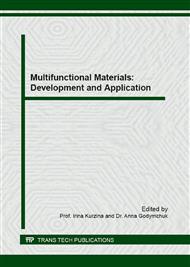[1]
V. Roshchanka, M. Evans, Playing hot and cold: How can Russian heat policy find its way toward energy efficiency?, Pacific Northwest National Laboratory, Richland, WA, (2012).
DOI: 10.2172/1053764
Google Scholar
[2]
G. Keikkala, A. Kask, J. Dahl, V. Malyshev, V. Kotomkin, Estimation of the potential for reduced greenhouse gas emission in North-East Russia: A comparison of energy use in mining, mineral processing and residential heating in Kiruna and Kirovsk-Apatity, Energ. Policy 35 (3) (2007).
DOI: 10.1016/j.enpol.2006.01.023
Google Scholar
[3]
A. Boyano, P. Hernandez, O. Wolf, Energy demands and potential savings in European office buildings: Case studies based on EnergyPlus simulations, Energ. Buildings 65 (2013) 19-28.
DOI: 10.1016/j.enbuild.2013.05.039
Google Scholar
[4]
R. Elsland, H. Bradk, M. Wietschel, A European impact assessment of the Eco-Design requirements for heating systems – What kind of savings can we expect?, Energy Procedia 62 (2014) 236-245.
DOI: 10.1016/j.egypro.2014.12.385
Google Scholar
[5]
A. Mirakyan, R. De Guio, Modelling and uncertainties in integrated energy planning, Renewable Sust. Energy Rev. 46 (2015) 62-69.
DOI: 10.1016/j.rser.2015.02.028
Google Scholar
[6]
Y. Zhang, Z. O'Neill, B. Dong, G. Augenbroe, Comparisons of inverse modeling approaches for predicting building energy performance, Build. Environ. 86 (2015) 177-190.
DOI: 10.1016/j.buildenv.2014.12.023
Google Scholar
[7]
D. Aviza, Z. Turskis, Robertas Volvaciovas, Correlation analysis of thermo-insulation layer thickness and its payback period of the typical pitched roof detail, Procedia Eng. 57 (2013) 120-126.
DOI: 10.1016/j.proeng.2013.04.018
Google Scholar
[8]
R. Dylewski, J. Adamczyk, Life cycle assessment (LCA) of building thermal insulation materials, in: F. Pacheco-Torgal , L.F. Cabeza , J. Labrincha, A. De Magalhaes (Eds. ), Eco-Efficient Construction and Building Materials. Life cycle assessment (LCA), eco-labelling and case studies, Woodhead Publishing Lim., Cambridge, 2014, pp.267-286.
DOI: 10.1533/9780857097729.2.267
Google Scholar
[9]
F. Balo, Feasibility study of green, insulation materials including tall oil: Environmental, economical and thermal properties, Energ. Buildings 86 (2015) 161-175.
DOI: 10.1016/j.enbuild.2014.09.027
Google Scholar
[10]
A. Kumar, B.M. Suman, Experimental evaluation of insulation materials for walls and roofs and their impact on indoor thermal comfort under composite climate, Build. Environ. 59 (2013) 635-643.
DOI: 10.1016/j.buildenv.2012.09.023
Google Scholar
[11]
J. Zhang, R. Rajkhowa, J.L. Li, X.Y. Liu, X.G. Wang, Silkworm cocoon as natural material and structure for thermal insulation, Mater. Des. 49 (2013) 842-849.
DOI: 10.1016/j.matdes.2013.02.006
Google Scholar
[12]
K. Wei, C. Lv, M. Chen, X. Zhou, Z. Dai, D. Shen, Development and performance evaluation of a new thermalinsulation material from rice straw using high frequency hot-pressing, Energ. Buildings 87 (2015) 116-122.
DOI: 10.1016/j.enbuild.2014.11.026
Google Scholar
[13]
F. Ardente, M. Beccali, M. Cellura, M. Mistretta, Building energy performance: A LCA case study of kenaf-fibres insulation board, Energ. and Buildings 40 (2008) 1-10.
DOI: 10.1016/j.enbuild.2006.12.009
Google Scholar
[14]
P. Evon, V. Vandenbossche, P. -Y. Pontalier, L. Rigal, New thermal insulation fiberboards from cake generated duringbiorefinery of sunflower whole plant in a twin-screw extruder, Ind. Crop. Prod. 52 (2014) 354-362.
DOI: 10.1016/j.indcrop.2013.10.049
Google Scholar
[15]
M.N. Morozov, P.A. Strizhak, Research of energy efficiency direct-heating systems with sequential connection of space heaters with different methods of heat consumption regulation, EPJ Web Conf. 82 (2015) 1-6.
DOI: 10.1051/epjconf/20158201047
Google Scholar
[16]
GOST R 54851-2011, National Standard of Russian Federation «Building envelope insimilar. Calculation reduced total thermal resistances», Standartinform, Moscow, (2012).
Google Scholar
[17]
M. Kıyan, E. Bingöl, M. Melikoglu, A. Albostan, Modelling and simulation of a hybrid solar heating system for greenhouse applications using Matlab/Simulink, Energ. Convers. Manage. 72 (8) (2013) 147-155.
DOI: 10.1016/j.enconman.2012.09.036
Google Scholar
[18]
T. Persson, Dynamic modeling of a domestic hot water system using Simulink, in: Proc. of 45th International Conf. of Scandinavian Simulation Society, Copenhagen, 2004, pp.199-206.
Google Scholar


